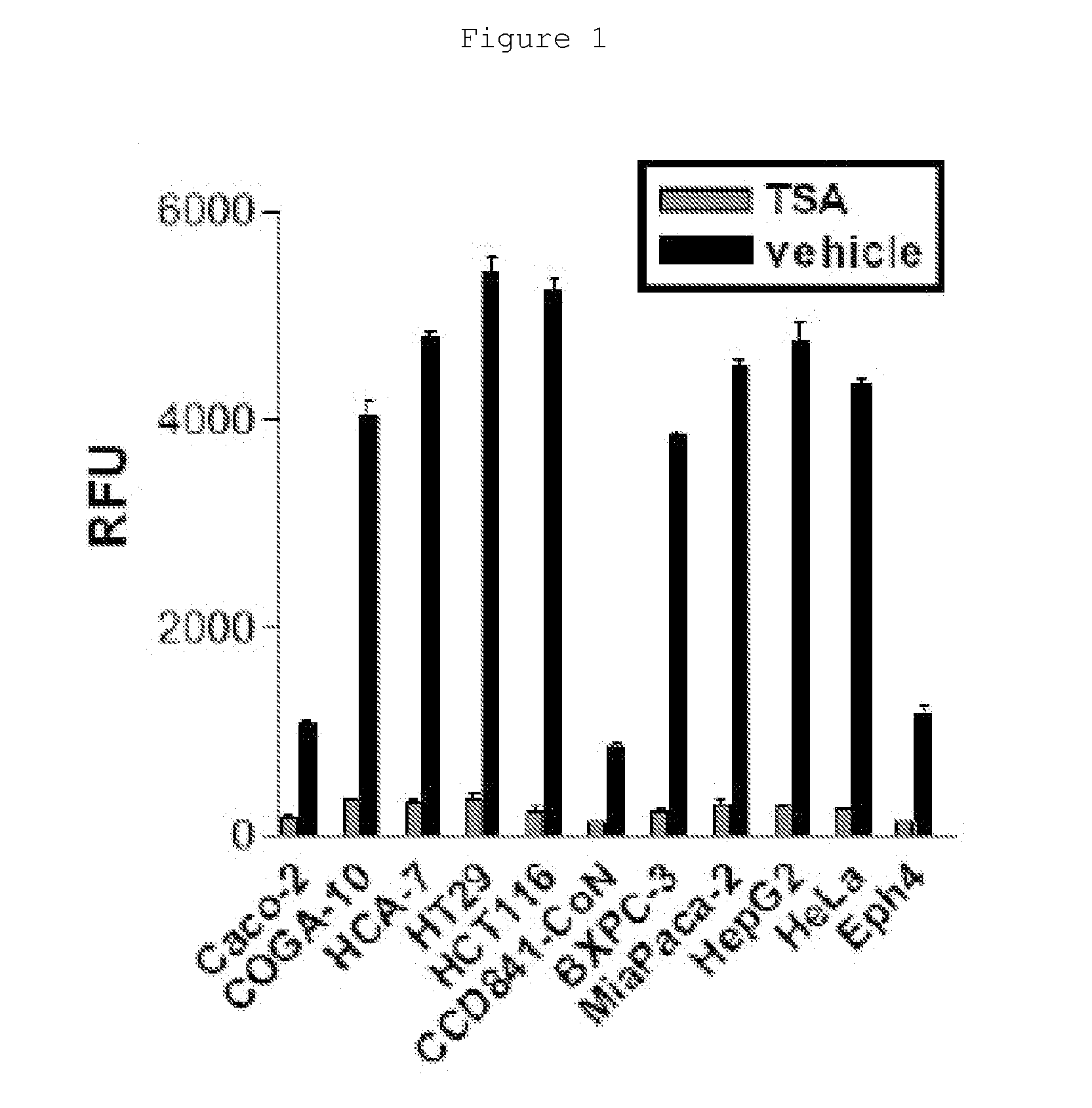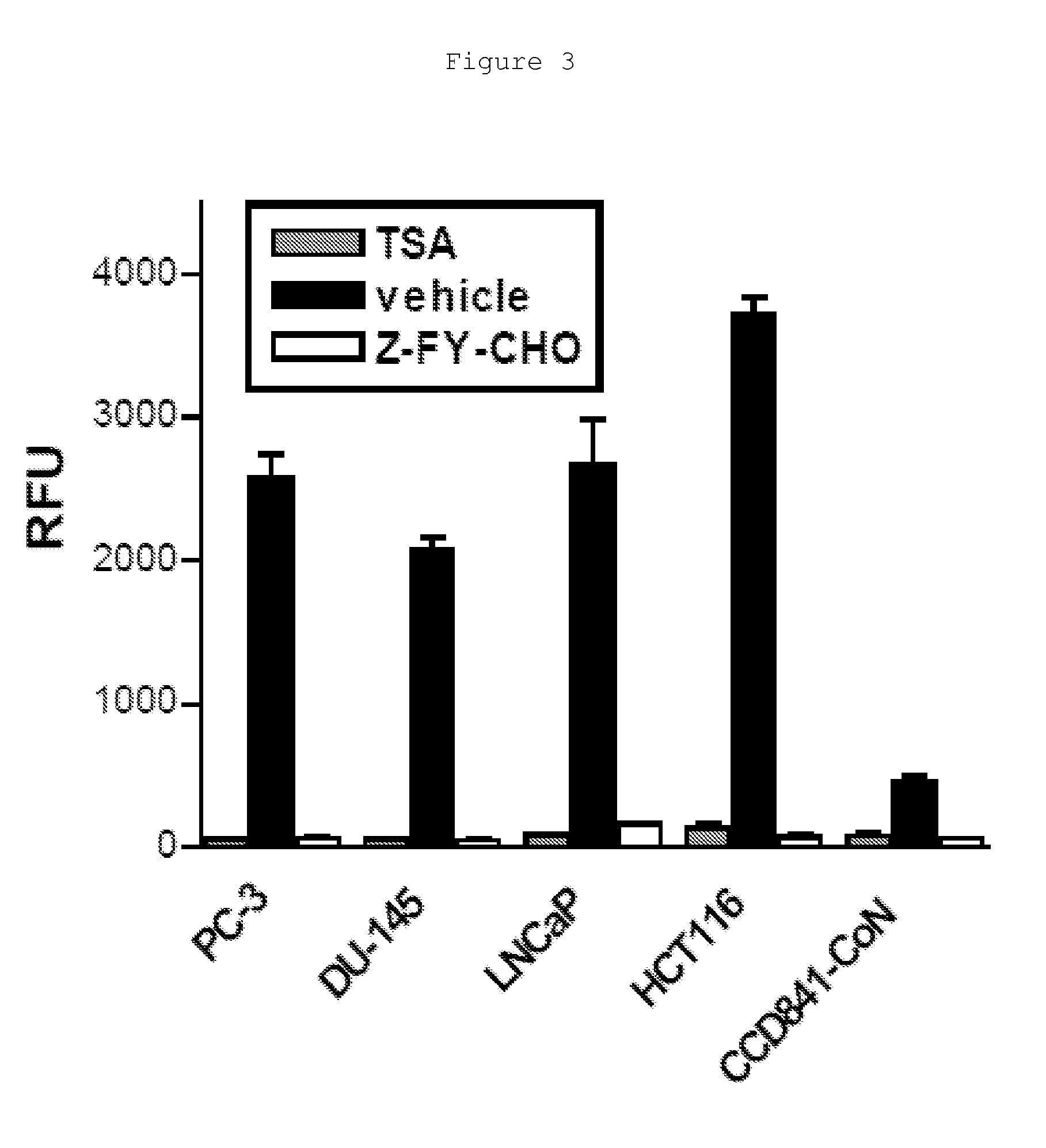Novel prodrugs for selective anticancer therapy
a prodrug and cancer technology, applied in the direction of drug compositions, peptides, peptides/protein ingredients, etc., can solve the problems of cancer treatment, increased toxicity, and reduced efficacy
- Summary
- Abstract
- Description
- Claims
- Application Information
AI Technical Summary
Benefits of technology
Problems solved by technology
Method used
Image
Examples
example 1
Levels of HDAC in Cancer Cells
[0358]To test the hypothesis that cancer cells have elevated levels of HDAC activity, HDAC activity was measured in a panel of human cancer cell lines including colon cancer (Caco-2, COGA-10, HCA-7, HT29, HCT116), pancreatic cancer (BXPC-3, MiaPaca-2), liver cancer (HepG2), and cervical cancer (HeLa), as well as non-tumorigenic human colon epithelial cells (CCD841-CoN) and normal mouse mammary epithelial cells (Eph4) (Mariadason, J. M. et al. 2001; Wegener, D. et al. 2003) (FIG. 1).
[0359]Using a standard fluorometric assay, marked high levels of HDAC activity was observed in all malignant cell lines tested but, in clear contrast, low levels in less-tumorigenic and normal cell lines (Caco-2, CCD841-CoN, Ehp4). The specificity of the HDAC activity was confirmed by a HDAC inhibitor Trichostatin A (TSA) (Yoshida, M. et al. 1990). Although Caco-2 cells originated from human colon adenocarcinoma, these cells are known to be less-tumorigenic and behave like no...
example 2
Boc-Lys(Ac)-AMC
[0360]Typical fluorogenic substrates for class I HDACs are comprised of an s-acetylated lysine residue (alone or in short peptides) coupled to a fluorophor moiety AMC (7-amino-4-methylcoumarin) such as cell-permeable Boc-Lys(Ac)-AMC (Wegener, D. et al. 2003; Bonfils, C. et al. 2008). The standard HDAC assay is based on the two-step conversion of the substrate: 1) HDAC-dependent deacetylation of ε-acetylated lysine, 2) protease-dependent cleavage of Lys-AMC amide bond and subsequent release of free fluorophor AMC, which fluoresces (Wegener, D. et al. 2003). In the tissue culture based assays, the second step is normally performed following cell lysis by addition of excessive amounts of trypsin, which only recognizes and processes deacetylated form of lysine. Given that the Lys-AMC amide bond can be cleaved by other endogenous proteases commonly associated with cancer cells such as lysosomal proteases (Weissleder, R. et al. 1999), it was hypothesized that the second ste...
example 3
Boc-Lys(Ac)-AMC vs. Ac-Arg-Gly-Lys(Ac)-AMC
[0363]Commercially available fluorescent compounds were used to measure HDAC activity in cells to obtain important preliminary data. Established substrates for the sensitive fluorogenic assay of class I HDACs are comprised of a short peptide sequences coupled with an s-acetylated lysine residue followed by a fluorophor moiety (Wegener, D. et al 2003). Such substrates include Boc-Lys(Ac)-X and Ac-Arg-Gly-Lys(Ac)-X, where X represents fluorophor moiety such as AMC. The assay was also based on the two-step conversion of the fluorogenic peptide substrate: 1) Intracellular HDAC-dependent deacetylation of ε-acetylated lysil moiety, 2) protease-dependent cleavage of Lys-X amide bond and subsequent release of free fluorophor. The second step required cell lysis followed by addition of excessive amounts of exogenous proteases (commonly trypsin) to the reaction.
[0364]Fluorescence measurement was done at λex=390 nm and μem=460 nm for AMC. FIG. 4A shows...
PUM
| Property | Measurement | Unit |
|---|---|---|
| diameter | aaaaa | aaaaa |
| pH | aaaaa | aaaaa |
| pH | aaaaa | aaaaa |
Abstract
Description
Claims
Application Information
 Login to View More
Login to View More - R&D
- Intellectual Property
- Life Sciences
- Materials
- Tech Scout
- Unparalleled Data Quality
- Higher Quality Content
- 60% Fewer Hallucinations
Browse by: Latest US Patents, China's latest patents, Technical Efficacy Thesaurus, Application Domain, Technology Topic, Popular Technical Reports.
© 2025 PatSnap. All rights reserved.Legal|Privacy policy|Modern Slavery Act Transparency Statement|Sitemap|About US| Contact US: help@patsnap.com



